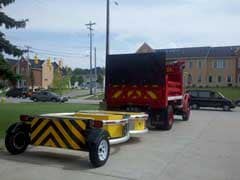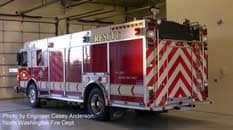One Career Fire Fighter Killed, Another Seriously Injured When Struck By a Vehicle While Working at a Grass Fire Along an Interstate Highway – South Carolina
 Death in the Line of Duty…A summary of a NIOSH fire fighter fatality investigation
Death in the Line of Duty…A summary of a NIOSH fire fighter fatality investigation
F2010-36 Date Released: January 20, 2012
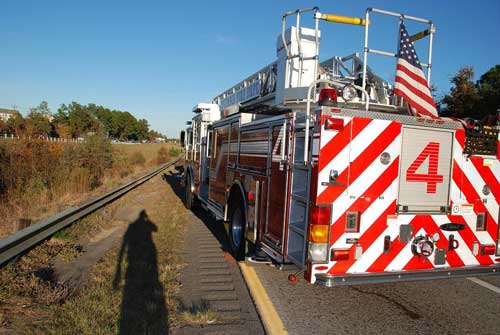
|
Executive Summary
On November 13, 2010 a 23-year-old career fire fighter (Victim) was struck and killed by a car while at the scene of a grass fire along a four lane, east-west, interstate highway. The highway was divided by a grassy, and in places underbrush-covered, median. A passing motorist saw the fire burning in the median and reported it to 911 who notified the local fire department. An engine (E24), and a quint (E4), were dispatched to the scene. E24 arrived ahead of E4 and parked next to the median straddling the fog linea and pulling into the passing lane to provide a protected work area for the fire fighters. E4 arrived one minute later and parked west of E24 pulling toward the guardrail to provide a traffic block.
At the same time, a car and a van were travelling eastbound toward the parked fire apparatus. Both vehicles were in the passing lane when the van hit the back of the car. Following the collision, the van drove on the shoulder of the passing lane and stopped before reaching E4. The car travelled onto the left shoulder of the highway passing between both apparatus and the guardrail before striking the two fire fighters. The injured fire fighter was thrown into the median by the impact and suffered critical injuries but survived. The Victim landed onto the road shoulder. Fire fighters who were on the scene initiated patient care measures immediately. The Victim was transported to a local trauma center and despite resuscitative efforts, he was pronounced dead.
aA line painted on a road that marks the edge of the legally drivable portion.
Contributing Factors
- An errant vehicle was able to enter into a roadway emergency work zoneb and strike fire fighters who were attending to an emergency incident.
- There was minimal time for the Victim to react and protect himself from the oncoming vehicle due to its speed and his position at the scene.
Key Recommendations
- Develop pre-incident plans regarding response protocols, scene safety, and traffic control for roadway emergency work zones in conjunction with public safety agencies, traffic management organizations and private sector responders.
- Develop, train on, and enforce standard operating procedures (SOPs) for roadway incidents that include response protocols for all possible types, locations, and durations of emergency roadway incidents that may occur within the department’s jurisdiction
- Ensure that all members receive training for responding to roadway incidents, with specific instruction on positioning apparatus to protect emergency workers from oncoming traffic
- Develop and train members on a situational awareness program that addresses hazards specific to working in a roadway emergency work zone.
bA roadway emergency work zone is an area where response personnel are attending to an emergency situation along a roadway where moving traffic is present. The emergency work zone extends from the first warning sign or high intensity rotating, flashing, oscillating, or strobe lights on a vehicle, to the last temporary traffic control device.
Introduction
On November 13, 2010, a 23-year-old career fire fighter (the Victim) was struck and killed by a car while at the scene of a small grass fire that had been burning in the median of a four-lane interstate highway. On November 15, 2010, the U.S. Fire Administration notified the National Institute for Occupational Safety and Health (NIOSH) of this incident. On December 1, 2010, a safety and occupational health specialist from the NIOSH Fire Fighter Fatality Investigation and Prevention Program traveled to South Carolina to investigate this incident. The NIOSH investigator conducted an opening conference with the acting chief of the department, the department division chiefs and a representative from the State Fire Marshal’s office. Meetings and interviews were conducted with fire department personnel who were involved in the incident or who were present on the scene. The State Patrol officer who investigated the incident was contacted by phone. Copies of the fire department’s standard operating procedures (SOPs), training records, witness statements, death certificate, the crash reconstruction report, and photos of the incident scene were reviewed.
Fire Department
This combination fire department has 32 stations with 515 active fire fighters of which 392 are paid career and 123 are volunteers. The department works a 24-on and 48-off shift schedule. Fourteen of the 32 stations are staffed by volunteers with one career staff person on duty. The department serves a geographical area of approximately 660 square miles which encompass both the county and city populations. The county population is about 372,000 of which approximately 129,400 are city residents. However, due to workers who commute to various government agencies and businesses the city population can increase to approximately 400,000 during the day. The department responds to approximately 25,000 to 30,000 emergency incidents per year.
The department involved in this incident had a SOP on roadway operations that was revised following the incident to incorporate more definitive guidance on methods to protect emergency responders who are attending to a roadway incident.
Training and Experience
The department involved in this incident has an established fire fighter entrance process that involves a written examination, physical agility and maze test, personal interview with the fire chief, psychological evaluation and physical examination. Fire fighter recruits who successfully pass the application process but have no prior experience are required to complete a 16 week training program. Applicants with experience can enroll into a seven to nine week accelerated program. Upon successful completion of recruit school, a fire fighter then must complete a six-month probationary period.
Once hired, fire fighters must then complete extensive training that includes requirements for successful completion of Fire Fighter I and II in accordance with the provisions set forth by the National Fire Protection Association (NFPA 1001, Professional Qualifications for Fire Fighters.)1 The training department is headed by a Chief of Training. The training facility is comprised of classrooms, a burn and smoke building, and a tower. The department works in conjunction with the State Fire Academy and the Department of Labor, Licensing and Regulation, Division of Fire and Life Safety to ensure compliance with all applicable State training requirements.
The Victim in this incident had served three years as a career fire fighter and all were with the same department. He had completed over 200 hours of formal training including NFPA Fire Fighter Levels I and II, Interior Structural Firefighting, Rapid Intervention, Rescuing the Rescuer, Hazardous Material Operations, Auto Extrication, and Rope Rescue. The fire department had roadway safety training modules and hands-on and classroom driver/operator training. The Victim had participated in both training modules.
Equipment and Personnel
This incident involved two fire service personnel (Victim and injured fire fighter) and four vehicles, a car, a van, and two fire apparatus as described below. According to the State Patrol report, there were no causal mechanical defects, nor pertinent vehicle recalls found on either POV1 or POV2.
POV1 – 2006 car (personally owned vehicle [POV) with a driver only. It sustained rear damage caused by the initial collision (See Photo 1) and damage to both sides caused by contact with the apparatus and guardrail (See Photo 2 and Photo 3).
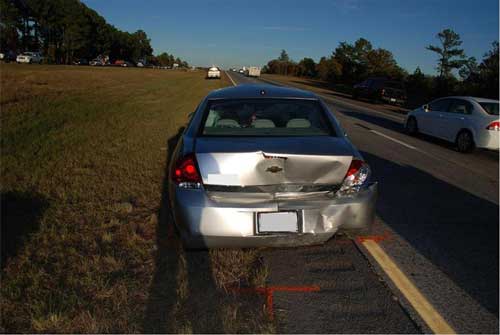 |
|
Photo 1. Photo showing collision damage |
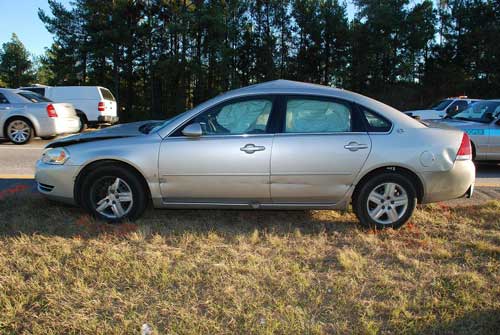 |
|
Photo 2. Photo shows driver’s side damage to POV 1 |
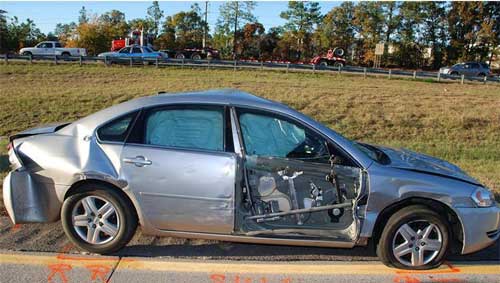 |
|
Photo 3. Photo shows passenger side damage to POV 1 caused by impact with fire apparatus. |
POV 2 – 1997 van that had a driver and five occupants. This vehicle sustained front-end damage caused by the initial collision with POV 1 (see Photo 4.)
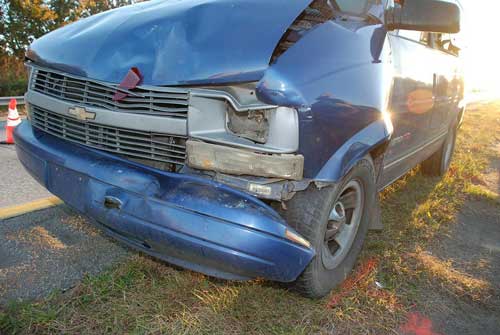 |
|
Photo 4. Photo shows collision damage to the front of POV 2. |
E24 – 2007 engine with an engineer/operator, officer, and two fire fighters. This apparatus sustained minor driver-side rear damage when struck by POV 1 (see Photo 5).
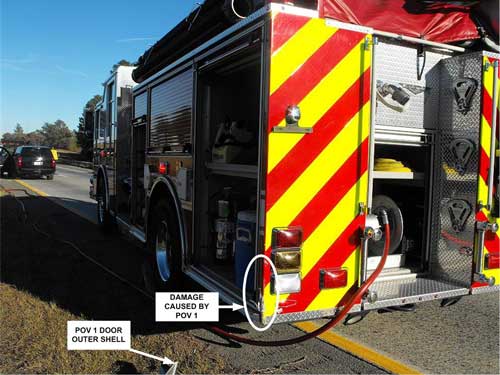 |
|
Photo 5. Photo shows damage to the back of E24 caused by POV 1. |
E 4 – 2009 heavy duty, aerial ladder quint with an engineer/operator, officer, and two fire fighters (Victim and FF1.) This apparatus sustained minor damage to the front bumper driver’s side when it was struck by POV1 (see Photo 6).
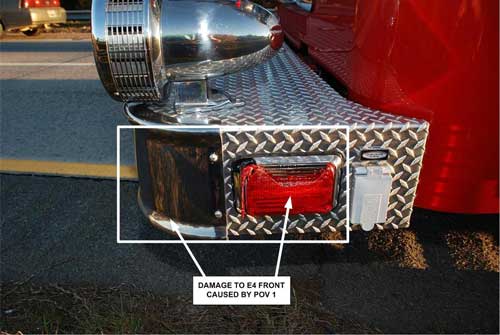 |
|
Photo 6. Photo shows minor damage to the front of E4 caused by POV 1. |
E24 and E4 were parked along the median shoulder facing eastbound (see Photo 7).
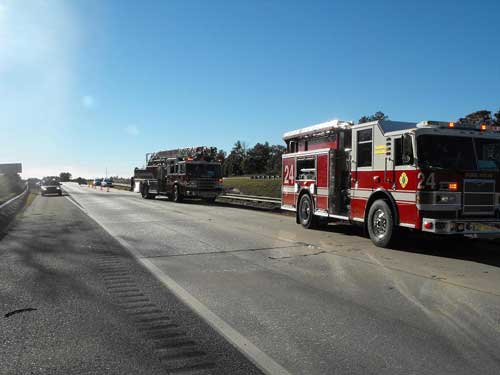 |
|
Photo 7. Photo shows parked apparatus locations at the scene. Both apparatus were facing eastbound. |
Note: The police vehicle discussed below was not involved in the fatal incident. This information is provided for reference purposes only.
It was reported that while at the scene, police attempted to drive a patrol car between E4 and the guardrail (see Photo 8). The police car was too wide. The specification sheet for police interceptor vehicles that are the same year and model as the one pictured lists the width as 78.2″.2 Following the incident, POV1 was measured and reported to be 73″ wide. The difference between the widths of the two vehicles is 5.2 inches; which indicates that POV1 had an approximate five inch clearance between the guardrail and E4.
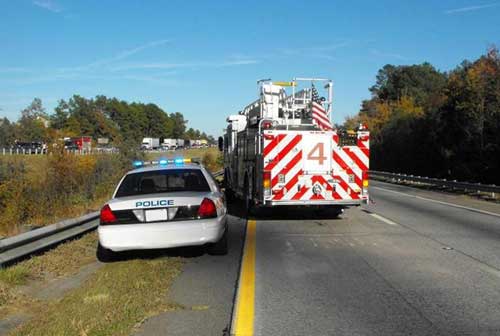 |
|
Photo 8. Photo shows a police patrol car between guardrail and E4. |
Timeline
The timeline for this incident is limited to the initial response of units dispatched to a grass fire in the interstate highway median on November 13, 2010.
- 1401 Hours
Engine 4 (E4) and Engine 24 (E24), were dispatched to a grass fire in the median of an interstate highway. - 1403 Hours
E4 and E24 radioed to dispatch that they are en-route to the grass fire. - 1407 Hours
E24 arrived on the scene and reported to E4 that they could cancel. E4 responded that they were close and would continue to the scene to provide an additional traffic block. - 1408 Hours
E4 arrived on the scene with the Victim and the fire fighter who was injured. - 1413 Hours
E24 officer called dispatch to report that a fire fighter was struck by a vehicle and emergency medical services (EMS) was needed immediately at the scene.
Personal Protective Equipment
Both the Victim and the fire fighter were wearing turnout coat and pants, boots, helmets and retro-reflective vests.
Weather Conditions
The roadway where the incident occurred was a State-maintained public four-lane interstate highway running in an east/west direction. The asphalt surface was in good repair and was bordered on both sides by paved rumble strips and partially grass-covered shoulders. There was a metal guardrail running along both east and west bound shoulders in the area where the incident occurred. The inside lane guardrail was likely installed because of an approximate 30 foot sloping drop into a grass and underbrush-covered gully. The grass fire was located in the gully area. The road had a slight uphill grade that crested approximately ¼ of a mile before the location where E4 had parked to block traffic (see Photo 9). The posted speed limit in the area was 60 MPH.
The roadway was dry at the time of the incident and the ambient air temperature was approximately 72° Fahrenheit (F) with clear skies.3 When E24 arrived they found the grass fire to have mostly self-extinguished and was smoldering. Smoke was negligible and visibility was not a factor. Neither the weather nor the road conditions appeared to be a negative contributory factor in this incident. At the crest of the slight grade, the road was straight with no obstructions.
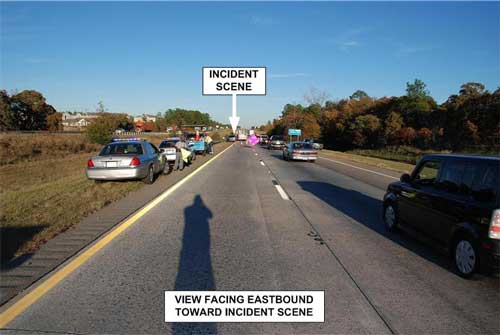 |
|
Photo 9. Photo showing the roadway east and |
Investigation
On November 13, 2010, at 1400 hours a motorist traveling along an interstate highway called 911 to report a grass fire burning in the median area. At 1401 hours, E24 and E4 were dispatched and at 1403 hours both reported they were en-route. At 1407 hours E24 with an engineer/operator, officer, and two fire fighters arrived on the scene. They parked next to the median straddling the fog line and pulling into the passing lane to provide a protected work area. Upon arrival, E24 radioed to E4 and told them to cancel due to the minimal size and condition of the grass fire. E4 responded that they were right behind E24 and would continue to the scene to provide an additional traffic block.
The fire appeared to have mostly self-extinguished by the time E24 arrived. It had been located in the highway median burning close to the road shoulder. The median in the area of the fire was downward sloping and covered by grass and underbrush. The two fire fighters who arrived in E24 pulled a booster line and one fire fighter proceeded down the embankment into the median to extinguish any remaining hot spots while the other fire fighter remained near the guardrail.
E4 arrived on the scene at 1408 hours with a driver, officer, the fire fighter who was injured, and the Victim. The E4 driver pulled behind E24 and positioned the apparatus at an angle facing the median. After exiting and surveying his location, the driver decided to re-position E4 to reduce the space between the apparatus and the guardrail. The E4 Officer then proceeded to the front of E24 to speak to the E24 Officer. The Victim and injured fire fighter donned retro-reflective vests, exited the apparatus and walked to the front of E24 to see if there was anything they could do to assist. The Victim was helping to advance the booster line, and both he and the injured fire fighter had their backs toward the apparatus and were facing eastbound. They were speaking to the fire fighter who was on the nozzle in the median and the other fire fighter from E24 who was standing along the guardrail.
At approximately the same time, POV 1 and POV 2 were travelling eastbound on the interstate highway toward the scene of the grass fire. Both were in the passing lane when POV 2 crashed into the back of POV 1. The State Patrol crash reconstruction report stated that POV 1 was traveling at 36 MPH and POV 2 was traveling at 60 MPH when the collision occurred. Following the crash, POV 2 travelled onto the passing lane shoulder and stopped to the east of E4 (see Photo 10). POV 1 also travelled onto the passing lane shoulder but did not stop. It continued eastbound on the shoulder traveling between the guardrail and both apparatus, clipping the front bumper of E4 and the rear bumper of E24 before striking the Victim and injured fire fighter (see Photo 11). The fire fighter from E24 who was standing along the guardrail was able to see the car in time to jump to safety over the guardrail. POV 1 sustained major damage to the trunk area from the initial collision, damage to the front from hitting the fire fighters, and damage to the driver and passenger sides, including peeling off the covering of the passenger side door, as it travelled between the apparatus and the guardrail (see Photo 3). It did not come to a complete stop until approximately 360′ after hitting the fire fighters (see Diagram).
At 1413 hours, within five minutes of arriving on the scene, the E24 officer notified dispatch that a fire fighter had been struck by a car and emergency medical services were needed immediately. The injured fire fighter was treated at the scene and transported to a local trauma center where he was hospitalized in critical condition with multiple injuries. Fire fighters, who were on the scene, immediately performed life saving measures on the Victim. He was transported to a trauma center where despite resuscitative efforts he was pronounced dead.
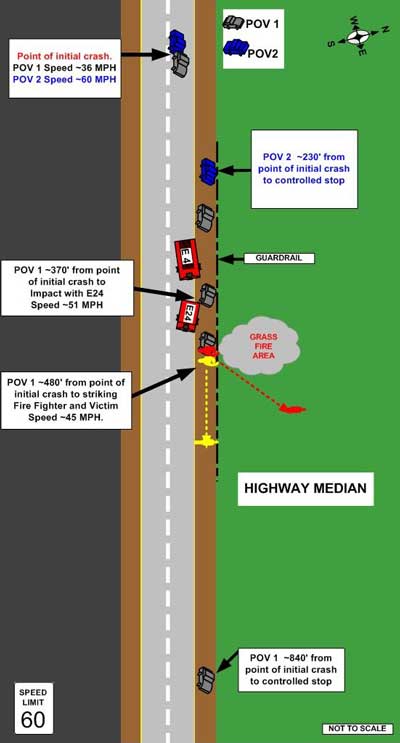 |
|
Diagram shows an aerial depiction of the incident scene. |
Contributing Factors
Occupational injuries and fatalities are often the result of one or more contributing factors or key events in a larger sequence of events that result in the injury or fatality. NIOSH investigators identified the following items as key contributing factors in this incident that led to the fatality:
- An errant vehicle was able to enter into a roadway emergency work zone and strike fire fighters who were attending to an emergency incident.
- There was minimal time for the Victim to react and protect himself from the oncoming vehicle due to its speed and his position at the scene.
Listed below are events which occurred in this incident and can serve as a reminder to all roadway emergency responders that regardless of implemented prevention strategies, unpredictable events can occur within minutes of arriving on the scene, and danger is always present when operating in roadway emergency work zones where moving traffic is present.
- The grass fire appeared to E24 officer to be self-extinguishing upon arrival and time on the scene was expected to be 30 minutes or less.
- E24 did not establish an advance warning transition area with cones and signs because of the anticipated short duration of the incident and the fact that E4 was arriving immediately to provide an additional traffic block.
- E4 operator took deliberate action by repositioning E4 to move closer to the guardrail while maintaining a traffic block for E24.
- The action of POV 1 that caused the fatality occurred within six minutes of the arrival of E24 and five minutes of the arrival of the Victim in E4.
According to the police report, POV 2 came to a complete stop west of E4 (see Photo 10.)
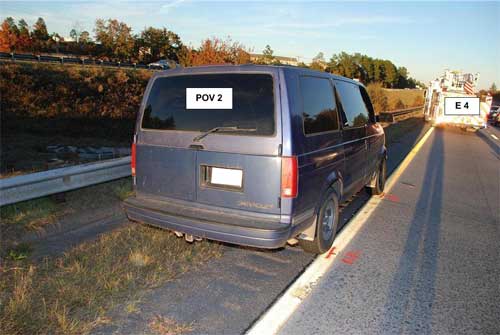 |
| Photo 10. Photo shows locations of POV2 and E4 after the incident. (Photo courtesy of State Patrol.) |
According to the State Patrol report, POV 1 did not come to a complete stop until past, and to the east of, the incident scene (see Photo 11.)
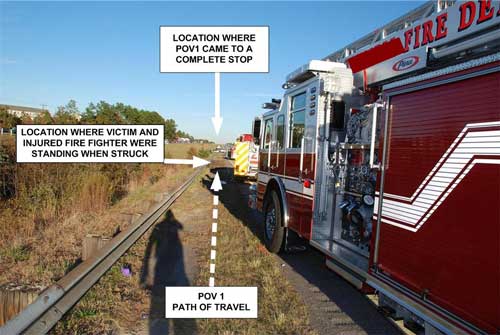 |
|
Photo 11. Photo shows the path of travel of POV1. |
Cause of Death
The cause of death was attributed to multiple trauma.
Recommendations
Recommendation #1: Fire departments should develop pre-incident plans regarding response protocols, scene safety, and traffic control for roadway emergency work zones in conjunction with public safety agencies, traffic management organizations and private sector responders.
Discussion: Pre-incident planning is fundamental to effective traffic control and management. According to the Emergency Responder Safety Institute, a preplan should: (1) account for possible use of detours; (2) anticipate the likelihood of vehicles transporting hazardous materials or of extraordinary weight or size; (3) accommodate the need to keep commerce flowing; (4) minimize the possibility of secondary incidents; and (5) account for possible impact on neighboring jurisdictions.4 According to the US Fire Administration document, Traffic Incident Management Systems,5 specific concepts that should be addressed in pre-incident planning for roadway incident operations include the following:
- All agencies that may respond to roadway incidents should be fully involved in the process, formatting and developing the plan, and ensure that the final plan is easily understood and implemented within their agency. (As noted in NFPA 1620 Section 4.1.9)
- Each agency involved must provide initial and refresher training, and ensure that individual and organizational roles are understood. (As noted in NFPA 1620 Section 4.8)
- Each agency should make sure that personnel are at least minimally briefed on the roles and procedures of other plan participants to avoid on-scene confusion and conflict. (As noted in NFPA 1620 Section 4.9)
NFPA 1620 provides guidance to assist fire departments in establishing pre-incident plans. Pre-incident planning that includes agreements formed by a coalition of all involved parties.6 Governing entities including departments of transportation, in conjunction with fire departments, emergency medical responders, law enforcement, and private sector responders (i.e. tow truck operators) should develop pre-incident plans that include automatic response protocols for highway emergency scenes. States and municipalities should ensure that adequate funding is available to staff and equip emergency response protocols once jointly established and agreed upon by all parties involved.
Recommendation #2: Develop, train on, and enforce standard operating procedures (SOPs) for roadway incidents that include response protocols for all possible types, locations, and durations of emergency roadway incidents that may occur within the department’s jurisdiction.
Discussion: One of the primary means by which departments establish consistent operations and manage risk is through the adoption and enforcement of SOPs. The development and enforcement of SOPs related to emergency vehicle response procedures and roadway incident scene operations are particularly important due to the level of hazard these operations pose for responders.7 SOPs should include guidance on methods to protect all emergency responders on the scene and maintain a safe flow of traffic past, or around, the emergency work zone. Roadside emergency work zone SOPs should include specific direction on:
- establishing incident command
- performing initial scene size-up and continual assessment of risks,
- training on the need and methods for maintaining on-scene situational awareness
- safe travel response protocols, apparatus placement at the scene, and markings to increase visibility
- requirements for the use of personal protective equipment (PPE)
- safe placement of advance warning signs and transition areas.
The department involved in this incident had a SOP on roadway operations that was revised following the incident to incorporate more definitive guidance on methods to protect emergency responders who are attending to a roadway incident.
Recommendation #3: Fire departments should ensure that all members receive guidance and training for responding to roadway incidents, with specific instruction on positioning apparatus to protect emergency workers from oncoming traffic.
Discussion: Although it may be difficult to ensure emergency workers are protected from every danger that is presented by traffic moving past an emergency work zone, there are actions that can be taken to mitigate hazards. Department SOPs should outline methods to be followed based on pre-incident planning for responding to specific incidents. Pre-incident planning is crucial in determining response strategies that provide optimum protection for on-scene emergency responders.8
This incident reinforces the need for fire departments to improve training for firefighters on important factors to consider when positioning apparatus at incident scenes. Whenever possible, fire departments should consider the following points when arriving at an incident before positioning the truck:
- Blocking vehicles should be positioned at an angle (30 – 45 degrees) in any lane and/or shoulder area where there will be personnel working.
- Blocking apparatus can be positioned angled to the right or left depending on several factors:
- Use the angle of the truck to sufficiently cover the work zone and do not leave any openings large enough for a vehicle to pass through.
- Use the angle of the truck to guide traffic in the direction you want them to travel (angled to the right will help shift traffic into the right lanes while trucks angled to the left will help to shift traffic to the left).
- Consider the task at hand and where fire fighters will be working. If pulling hose lines and using a pump operator, consider angling the truck to protect the pump operator. Put the pump panel on the downstream side of the traffic flow.
- If the first in unit will be angled to protect the pump operator and the truck will not be positioned in the best way to direct traffic around the incident, a second unit should be positioned upstream of the first in unit angled in the direction you want traffic to flow. When the incident is of sufficient duration and it can be safely accomplished, supplement the blocking vehicle with the liberal use of cones, flares and warning signs.
- Remember that the angle of the truck helps approaching motorists to understand that the unit is stopped, parked and not moving.
- Remember to turn the steering wheel away from the incident work zone, set the brakes and deploy chock blocks. 4
The department in this incident took avoidance strategies by using E4 as a traffic block. The fact that this fatality occurred the way that it did emphasizes the need to always prepare for the worst case scenario when working near moving traffic. The Manual on Uniform Traffic Control Devices (MUTCD) guidelines can be utilized to establish emergency work zones and provide guidance to ensure that all tasks responders are required to perform can be done within an area that is protected from moving traffic.9 Departments should make every effort to utilize on-scene physical barriers such as guardrails, and area topography when possible, to create a protected work area that passing traffic cannot breach.
Recommendation #4: Fire departments should develop and train members on a situational awareness program that addresses hazards specific to working at a roadway emergency work zone.
Discussion: Situational awareness can be described as a genuinely heightened consciousness or cognizance of what is currently developing or occurring. Being alert to what is going on around at a roadway emergency incident is extremely critical because roadway incidents are always high risk events. Complacency, redundancy, and lack of situational awareness are issues that all responders must avoid. When responding to a roadway emergency incident, fire fighters and other first responders must ensure their personal safety, as well as the individuals they are trying to assist. Emergency personnel need to develop a heightened sense of awareness to detect impending dangerous situations and recognize warning signals such as screeching tires, horns, smoke or dust, and the sound of a crash or impact. Responders need to do a quick survey of the location where they are working and mentally prepare an escape strategy. 7
Approaching traffic may be driven at speeds from a creeping pace to well beyond the posted speed limit. Some of these drivers may be vision impaired, under the influence of alcohol and/or drugs, or have a medical condition that affects their judgment or abilities. Also, motorists may be completely oblivious to your presence due to distractions caused by cell phone use, loud music, conversation, inclement weather, and terrain or building obstructions. Approaching motorists will often be looking at the scene and not the roadway in front of them. Nighttime incidents requiring personnel to work in or near moving traffic are particularly hazardous. Visibility is reduced and driver reaction time to hazards in the roadway is slowed.7
To ensure that first responders maintain situational awareness, they need to understand the incident action plan which must be communicated by the Incident Commander at the beginning and maintained throughout the duration of the incident. The operations at a highway/roadway incident must be continually reassessed, especially as incident objectives are met, and additional resources arrive, and/or are released from the incident.10
It’s important for all emergency responders to remember that things can go very wrong very quickly at roadway emergency incidents. Fire departments need to ensure that multiple prevention strategies are in place and emergency responders must maintain an awareness to what is going on around them at all times. Fire departments should train members on how to identify and pre-plan an escape strategy should they encounter a dangerous situation such as an errant vehicle entering the emergency work zone.
In this incident, there was an approximate 78″ distance between the guardrail and E4. The relatively small space may have given the on-scene responders a false sense of security as to the likelihood that a vehicle would not be able to pass through the gap. Another factor in this incident is that the fire fighters who were struck were standing with their backs to the on-coming car, and due to its speed there was little time for them to react or remove themselves from the car’s path of travel.
Recommendation #5: Fire departments should ensure that a thorough scene size-up is conducted, incident command is established, and risks are assessed and managed throughout a roadway incident.
Discussion: Roadway emergency incidents that occur on or near moving traffic must be effectively and safely managed due to the multitude of risks encountered by fire department and other emergency response personnel. Other first responders can include law enforcement; emergency medical services; State, county, and/or local transportation agencies (e.g. department of transportation); and vehicle recovery agencies. Each agency has a responsibility based upon their designation. For example, law enforcement agencies are often the first to arrive at the incident scene, performing first responder duties, establishing emergency access routes, and control¬ling the arrival and departure of other responders. Fire and rescue agencies are needed at incidents that involve Victim rescue, fire fighting operations, or hazardous materials mitigation. They may be supported by emergency medical services (EMS) if the incident involves injuries. Transportation agencies perform a variety of duties related to traffic operations, motorist information, emergency roadwork, and incident clearance, as well as the first responder duties of highway service patrols. Finally, towing and recovery companies recover and remove vehicles and other debris from the scene.10
The management of an incident involving multiple agencies can be difficult. There is always a possibility of disagreement when determining who is in charge of what. Pre-incident planning to identify each responding agency and their particular role and responsibility can avoid disagreements when an incident occurs. In addition, mutual aid agreements should be established that identify specific responses to deliver appropriate equipment and staffing for the incident. Depending on the size and complexity of the incident, the option of single command or Unified Command must be considered. Regardless, the Incident Command System (ICS) must be used as this process is a systematic tool for the command, control, and coordination of an emergency response. ICS allows agencies to work together using common terminology and operating procedures for controlling personnel, facilities, equipment, and communications at an incident scene.11
During incident response, the ICS allows the transition to large and/or multiagency opera¬tions with only minimal adjustment for the agencies involved. While the ICS structure may be small initially, its flexibility allows the structure to expand and adapt to real-time conditions at the scene. If the incident grows in size and/or complexity, individuals in addition to the Incident Commander may be appointed to oversee their functional units to maintain a reasonable span of control and level of efficiency. It is imperative that “Command” be established by the first responding unit at all highway incidents. The Incident Commander is the overall safety officer and is responsible to ensure safe working conditions. Depending on the type, duration, and length of an incident, the Incident Command may appoint an Incident Safety Officer to monitor scene safety.
As in any other operation, accountability of personnel is mandatory. However in an incident where multi-agencies have personnel and resources at the incident scene, accountability is even more difficult. An accountability group may be established with representatives from multiple agencies assisting in this task. This is another issue for the pre-incident planning process. A personnel accountability system must be used to ensure that all responders are accounted for when on-scene and in the event that an incident occurs which requires the rapid accounting of all personnel on-scene.12
Recommendation #6: Fire departments should ensure that SOPs include guidance on how to properly establish advance warning and transition areas for highway emergency incidents.
Discussion: The Manual on Uniform Traffic Control Devices provides direction for establishing a protected work area for persons working along roadways, including emergency work zone responders. Chapter 6I provides instruction on the “Control of Traffic Through Traffic Incident Management Areas” which are defined as “an area of a highway where temporary traffic controls are installed, as authorized by a public authority or the official having jurisdiction of the roadway, in response to a road user incident, natural disaster, hazardous material spill, or other unplanned incident.” Traffic incidents are divided into three general classes according to the duration; major, intermediate, or minor, with each having unique traffic control characteristics and needs. A minor traffic incident has an expected duration of thirty minutes or less and typically results in lane closure of less than thirty minutes. MUTCD Section 6I.04.02 states that, “diversion of traffic into other lanes is often not needed or is needed only briefly. It is not generally possible or practical to set up a lane closure with traffic control devices for a minor traffic incident.”9
MUTCD Chapter 6G discusses temporary traffic control (TTC) zone activities which are organized according to duration, location, type of work, and highway type. Work duration is a major factor in determining the number and types of devices used in TTC zones. The duration of a TTC zone is defined relative to the length of time a work operation occupies a spot location. Work that occupies a location up to one hour is considered “short duration.” The guidelines for operations of short duration include; “Appropriately colored or marked vehicles with rotating/strobe lights may be used in place of signs and channelizing devices for short duration. According to the MUTCD, short-duration work often takes longer to set up and remove the TTC zone than to perform the work. Workers face hazards in setting up and taking down the TTC zone. Also, since the work time is short, delays affecting road users are significantly increased when additional devices are installed and removed. Considering these factors, simplified control procedures may be warranted for short-duration work. A reduction in the number of devices may be offset by the use of other more dominant devices such as high-intensity rotating, flashing, oscillating, or strobe lights on work vehicles.”9
The fire department in this incident was responding to a minor grass fire in a highway median. There was not an active incident scene in a roadway travel lane and no responders were working in a travel lane. The main incident area was actually off of the road entirely. MUTCD guidance for this situation can incorporate either or both scenarios described above: “traffic incident management area” and/or “temporary traffic control zone.” For short duration highway incidents (thirty minutes to one hour), both offer similar advice. The activity taken by the department in this case appears to be in compliance with the MUTCD recommendations.
In this incident, neither the department of transportation nor law enforcement was on the scene to assist with traffic management. The decision was made by the department that due to the anticipated short duration and minor scope of the incident, additional traffic management was not immediately needed. They decided to continually re-evaluate and request help if necessary. Although the department took a number of prudent highway incident safety measures, there are several additional procedures that should be considered to further enhance the safety of responders who are working in a roadway emergency work zone.
It is possible that an upstream emergency vehicle could have alerted traffic or warned the Victim. Also a properly positioned heavy-duty truck that was equipped with a large flashing directional arrow and truck mounted attenuatorc (see Photo 12 and Photo 13) could have absorbed the impact of the car prior to striking the victims. Many State and local highway departments have these types of trucks that are normally used for roadway maintenance, but can be called upon for use in emergency situations.
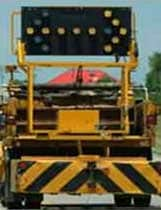
|
| Photos 12(left) and 13(right) show examples of truck mounted attenuators. |
It was recently reported that a fire department equipped a surplus municipal dump truck with lights, siren, reflective chevron strips on the back, a lighted road arrow sign, and a crash attenuator (see Photo 14 and Photo 15.) The truck was designed for use at roadway emergency incident scenes to protect the parked apparatus from moving traffic by placing it upstream directly to the back of the blocking apparatus.13
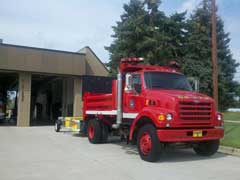
|
|
Photos 14(left) and 15(right) show a surplus municipal dump truck that |
NFPA1500 Standard on Fire Department Occupational Safety and Health Program provides guidance on the use of warning and transitional devices that are used for traffic control at roadway emergency incidents. When the use of signs and transitional devices are required, NFPA 1500 recommends that fluorescent and retro-reflective warning devices such as traffic cones and signs, as well as illuminated warning devices, such as highway flares, be used to warn oncoming traffic of an emergency work zone.14 The MUTCD designates fluorescent pink with black text as the best color for warning signs to identify active emergency work zones. Warning signs, flares and cones can improve the identification of fire apparatus, personnel and the emergency work zone. Flares used in conjunction with traffic cones with reflective collars can be very effective at channeling traffic around an incident scene.9 A model SOP for establishing advance warning and transition areas at highway-related incidentsexternal icon can be found at http://www.respondersafety.com/default.aspx.15 (Link Updated 1/28/2013)
When traffic control calls for a traffic control assistant at limited-access highway operations, fire departments should consider assigning a member to monitor approaching traffic and activate an emergency signal if the actions of a motorist do not conform to established traffic control measures that are in place at the incident scene. Traffic control assistants should be identified by the department in advance and training that is specific to the functions of the position should be provided. A traffic control assistant training program can be found by accessing the Responder Safety Institute websiteexternal icon, http://www.respondersafety.com/DownloadCategories/Training.aspx.16 (Link updated 4/9/2013) In this incident, it is possible that a traffic control assistant who was watching on-coming traffic could have alerted the Victims in time for them to move clear of the out of control car.
Due to the anticipated short duration of this incident, it was decided that placement of E4 to the rear of E24, provided a sufficient traffic block. It is possible that additional flares or reflective signage further upstream would have alerted an attentive driver to the emergency activity ahead. Even though the majority of motorists were alerted in time to safely move over and slow down, the fact that the series of events which occurred resulted in POV1 entering the emergency work zone and striking the fire fighters, is a reminder that regardless of the time involved, multiple prevention strategies are always the optimum practice.
Recommendation #7: Fire departments should ensure that fire fighters wear suitable high-visibility retro-reflective apparel while working non-fire emergency scenes near moving traffic.
Discussion: Both victims in this incident had just exited the apparatus and were wearing ANSI-compliant retro-reflective vests. The following information is being provided to assist fire departments when selecting safety apparel for responding to roadway incidents.
To meet minimum requirements for high visibility apparel, responders should only use vests that meet a Class II requirement of ANSI/ISEA 107-2010 (or subsequent revisions) or the requirements of ANSI/ISEA 207-2006 for Public Safety Vests. These minimum requirements include 1) use of fluorescent background material, 2) the fluorescent material may be yellow-green, orange-red, or red, 3) retro-reflective material arranged for 360 degree visibility and, 4) the garments should be labeled as compliant with ANSI/ISEA 107-2010 or ANSI/ISEA 207-2006. Federal Regulation 23 CFR 634 states, “The purpose of the regulations in this part is to decrease the likelihood of worker fatalities or injuries caused by motor vehicles while working within the right-of-way on Federal-aid highways.”17 NFPA 1500 8.7.10 states, “when members are operating at a traffic incident and their assignment places them in potential conflict with motor vehicle traffic, they shall wear a garment with fluorescent and retro-reflective material visible from all directions.14 All responders who are not involved in fire suppression activities should be wearing ANSI compliant high visibility garments when working near moving traffic and don the retro-reflective vests during scene clean-up following extinguishment.
Recommendation #8: Fire departments should ensure that high visibility chevrons and reflective markings are applied to all apparatus to enhance conspicuity while parked at emergency scenes and during emergency response.
Discussion: Highway incident scene safety has been at the forefront of efforts to reduce fire fighter death and injury. Several initiatives to increase conspicuity of emergency apparatus have been finalized and guidance has been provided to assist fire departments in implementing these procedures.18 NFPA 1901, Standard for Automotive Fire Apparatus, was revised and became effective in January 2009. Its purpose is to enhance visibility of emergency vehicles that are parked along roadways during emergency incidents. Chapter 1.3.1 states that ” This standard shall apply to new fire apparatus that meet the following criteria: (1) That have 10,000 lb (4500 kg) or greater gross vehicle weight rating (GVWR) or are trailers intended to be towed by fire apparatus under emergency response conditions. (2) That are designed for use under emergency conditions to transport personnel and equipment and to support the suppression of fires and mitigation of other hazardous situations, or (3) That are contracted for on or after January 1, 2009.” The specific marking requirements are outlined in NFPA 1901 Chapter 15.9.3.1 and 15.9.3.2 which state that “A retro-reflective stripe(s) shall be affixed to at least 50 percent of the cab and body length on each side, excluding the pump panel areas, and at least 25 percent of the width of the front of the apparatus. The stripe or combination of stripes shall be a minimum of 4 inches (100 mm) in total width. At least 50 percent of the rear-facing vertical surfaces, visible from the rear of the apparatus, excluding any pump panel areas not covered by a door, shall be equipped with retro-reflective striping in a chevron pattern sloping downward and away from the centerline of the apparatus at an angle of 45 degrees.” 19 NFPA 1901 applies to newly manufactured apparatus and is not retroactive. However, in many cases it can be cost effective and easy to retrofit existing apparatus to improve fire fighter emergency work zone safety. Fire departments should consider putting reflective tape on apparatus to mark doors, fixed sections that are not blocked by doors or ladder racks, and also down low around the bottom of the apparatus. A video detailing guidance for retrofitting apparatus with the newly recommended safety lighting and markings can be found by accessing the Emergency Responder Safety Institute websiteexternal icon, http://www.respondersafety.com/MarkedAndSeen.aspx. 20
Roadway incident response safety procedures call for fire apparatus to park on an angle at roadway incident scenes to create a work area that is protected from passing traffic. Often apparatus emergency lighting is not as effective when parked at an angle. A more effective design calls for emergency lights to be mounted up high on the back of the apparatus to provide 360º visibility. There is evidence that amber lighting on the rear of apparatus can be very effective at warning motorists of an active emergency work zone. Amber lights convey a message of caution and motorists are accustomed to slowing down for amber warning lights in highway construction work zones.20
Photo 16 and 17 show an example of reflective directional arrow markings that have been applied to the sides of a rescue unit. These side markings are arrow shaped to present a visual message that will direct motorists around and away from the emergency work zone. Amber directional lighting has also been installed on the upper rear sides to improve visibility when the truck is parked at an angle.
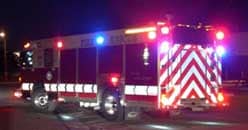
|
| Photos 16(left) and 17(right) show reflective directional arrow markings in daylight and darkness. (Photo courtesy of North Washington Fire Protection District, Denver, CO). |
Recommendation #9: Governing authorities, Federal, State, Regional and Local, having jurisdiction should consider enacting, or enhance existing, “Slow Down, Move Over” legislation to include provisions that will help protect emergency responders who are working near moving traffic at highway emergency work zones.
Discussion: Slow-down, move-over laws require motorists who are traveling on multi-lane roadways to, when practical, merge away from an emergency vehicle working on the side of the highway to provide an empty travel lane of safety for the emergency responder. If not practical (due to road design or traffic volume) the motorist must slow down significantly below the posted speed limit while passing the emergency work zone. Model language for a “Slow-Down, Move-Over” law includes a provision that if a violation of the move over law results in a catastrophic injury or death to another person, in addition to any other penalty imposed by law, the violator’s driver’s license shall be suspended for a period of at least one year but not more than five years, and sentenced up to one year in jail.21
According to the Governors State Safety Association, all states have laws that increase the penalties for speeding or committing traffic violations when traveling in a highway construction work zone. Often monetary fines that are imposed for traffic violations that are committed outside of a construction zone will be doubled if those same traffic violations occur within a highway construction zone when workers are present or signs are posted. Twenty-six states double the fine for speeding or committing other traffic violations in a highway work zone. Thirty-four states have increased fines only for speeding. The remainder increase fines for speeding and other traffic violations. Twenty-four states require workers to be present in the construction zone for the increased penalties to take effect. 22
Emergency responders who are operating at an incident scene where they are exposed to moving traffic are working in a “highway emergency work zone.” They are always present when there is a highway emergency incident and are possibly less able to concentrate on their surroundings than highway construction personnel due to intense life and death situations and the nature of their work. To promote a comparable level of awareness and help protect emergency responders while working at highway emergency scenes, governing authorities should consider enacting legislation, similar to highway construction work zone laws, that includes increased monetary penalties for traffic violations committed within an emergency work zone.
Currently South Carolina has a “Move Over” law that requires motorists to move over into an adjacent lane whenever possible if they encounter an emergency scene that is identified by emergency vehicles with flashing lights, rescue equipment, or emergency personnel on scene. Drivers approaching an emergency scene are required by law to:
- Keep their vehicle under control
- Proceed with due caution
- Significantly reduce their vehicle speed
- Yield the right of way by making a lane change into a lane not adjacent to the temporary work vehicle or equipment if on a highway with at least four lanes, with at least two lanes proceeding in the same direction
- Maintain the safe speed for road conditions if changing lanes is impossible or unsafe.
Provisions in the current South Carolina law specify that endangering emergency personnel is considered a misdemeanor punishable by a fine of not less than $300 or more than $500.23
Recommendation #10: Additionally, governing authorities having jurisdiction should consider adopting “Intelligent Transportation Systems (ITS)” and incorporate “slow down, move over” verbiage into crash warning messages that are broadcast on the national ITS (511) system.
Discussion: On July 21, 2000 the Federal Communications Commission (FCC) designated “511” as the single traffic information telephone number to be made available to States and local jurisdictions across the United States. It is known as “America’s traveler information telephone number.” The FCC ruling left implementation issues and schedules to State and local agencies and telecommunications carriers. Many states have enacted the 511 traveler information telephone number to include traffic conditions including accidents, highway construction updates, weather and road conditions and alerts.24
When travelers are alerted to an emergency highway incident through the 511 notification system, a brief statement that would include verbiage such as “please be alert to emergency workers and remember to slow down and move over when you are passing an emergency incident scene” would be a timely reminder and increase drivers’ awareness of the upcoming emergency activity. Governing entities should consider including stipulations for such announcements when implementing a 511 traveler information system.
cA truck mounted attenuator is a portable impact attenuator attached to the rear of a large truck. It is used as a shield to prevent errant vehicles from entering a highway work zone. They are frequently used in short-term or mobile work zones.
References
- NFPA [2008]. NFPA 1001, Standard for fire fighter professional qualifications. 2008 ed. Quincy, MA: National Fire Protection Association.
- Ford Motor Company [2002]. Arresting Features, 2002 Ford Crown Victoria Police Interceptor: https://www.fleet.ford.com/downloads/specvehpolice/police.pdf Date accessed: (Link no longer available 8/8/2013)
- Weather underground [2011]. History Saturday, November 13, 2010:external icon http://www.wunderground.com/history/airport/KCUB/2010/11/13/DailyHistory Date accessed: August 2011
- Protecting Emergency Responders on the Highways.external icon Responder Safety Institute website: http://www.respondersafety.com/DownloadCategories/White_Papers.aspx. Date accessed: September 2011.
- US Fire Administration [2008]. Traffic Incident Management Systems.pdf iconexternal icon Emmitsburg, MD: Federal Emergency Management Agency, US Fire Administration. www.usfa.fema.gov/downloads/pdf/publications/tims_0408.pdf (Link Updated 1/28/2013)
- NFPA [2010]. NFPA 1620. Standard for pre-incident planning. 2010 ed. Quincy, MA: National Fire Protection Association.
- International Association of Fire Fighters [2010]. Best Practices for Emergency Vehicle and Roadway Operations Safety in the Emergency Servicesexternal icon http://www.iaff.org/hs/EVSP/home.html . Date accessed October 2011
- NIOSH [2001]. NIOSH Hazard ID: Traffic Hazards to Fire Fighters While Working Along Roadways. Cincinnati, OH: U.S. Department of Health and Human Services, Public Health Service, Centers for Disease Control and Prevention, National Institute for Occupational Safety and Health, DHHS (NIOSH) Publication No. 2001-143.
- FHWA [2009]. Manual on Uniform Traffic Control Devices.external icon Washington, DC: U.S. Department of Transportation, Federal Highway Administration (FHWA). http://mutcd.fhwa.dot.gov/htm/2009/html_index.htm. Date accessed: August 2011.
- NFPA [2008]. NFPA 1561: Standard on emergency services incident management system. 2008 ed. Quincy, MA: National Fire Protection Association.
- Simplified Guide to the Incident Command System for Transportation Professionals.external icon http://ops.fhwa.dot.gov/publications/ics_guide/ Date accessed: November 2011.
- National Capital Regional Transportation Planning Board [2010]. Long Range Transportation Plan/ State Strategic Highway Safety Plansexternal icon. http://www.mwcog.org/clrp/elements/safety/shsps.asp
- GRFD Unveils Its Traffic Safety Unit [2011]. http://www.youtube.com/watch?v=1JAqE99iAaA. Date accessed: October 2011.
- NFPA [2007]. NFPA 1500, Standard on fire department occupational safety and health program. 2007 ed. Quincy, MA: National Fire Protection Association.
- Model Standard Operating Guideline (SOG) for Cone, Flare, or Sign Deployment at Traffic-related Incidents.external icon Responder Safety website: http://www.respondersafety.com/Articles/Model_SOG_Available_for_Download_on_Deploying_Cones_and_Flares_at_Roadway_Incidents.aspx . Date accessed: October 2011.
- Developing Traffic Assistant Control Programs.external icon Emergency Responder Safety Institute website: http://www.respondersafety.com/DownloadCategories/Training.aspx Date accessed: June 2011. (Link updated 4/9/2013)
- Be Right Be Bright.external icon Emergency Responder Safety Institute website: http://www.respondersafety.com/BeRightBeBright.aspx. Date accessed: October 2011.
- Sullivan J [2009]. Innovations In Apparatus Conspicuityexternal icon http://www.firerescue1.com/print.asp?act=print&vid=508854 Date accessed: October 2011.
- NFPA [2009]. NFPA 1901, Standard for automotive fire apparatus. 2009 ed. Quincy, MA: National Fire Protection Association.
- Marked and Seen,external icon Emergency Responder Safety Institute website, http://www.respondersafety.com/MarkedAndSeen.aspx . Date accessed: October 2011.
- Model Language for a Move Over Law.external icon Responder Safety Institute website: http://www.respondersafety.com/About-Us/Key-Initiatives/Move-Over-Law/Default.aspx?qs=922732E8F28CA3BD62BB6C30A2A34DAE86055B69B3B687AE Date accessed: June 2011. (Link updated 5/13/2015)
- Work Zone Speed Limit Laws.external icon Governors Highway Safety Association website: http://www.ghsa.org/html/stateinfo/laws/sanctions_laws.html Date accessed: June 2011
- SC Department of Transportation Installs “Move Over” Signs Along Interstates Across South Carolinaexternal icon [2009]. http://info.scdot.org/PressRelease/Lists/Posts/Post.aspx?List=02fa2710%2D0281%2D4b71%2D8897%2D59896828dc20&ID=
1251&Web=e9ffbcd1%2D2766%2D4d9e%2D86d4%2D08feb4f17e3e (Link Updated 1/28/2013) - America’s Traveler Information Telephone Number, What Is It?external icon U.S. Department of Transportation, Federal Highway Administration website: http://www.fhwa.dot.gov/trafficinfo/511what.htm Date accessed: August 2011.
Additional Information
- The Emergency Responder Safetyexternal icon Institute serves as an informal advisory panel of public safety leaders who are committed to reducing deaths and injuries to America’s Emergency Responders. http://www.respondersafety.com/default.aspx (Link Updated 1/28/2013)
- Downloadable training programs are availableexternal icon at http://www.respondersafety.com/DownloadCategories/Training.aspx (Link updated 4/9/2013)
- A SOP Word template “SOP/SOG For Your Fire Department Safe Positioning While Operating or Near Moving Traffic” external iconhttp://www.respondersafety.com/Download.aspx?downloadID=2c3b900d-bf89-4142-acee-063397f372aa
- United States Fire Administration – Publication on Traffic Incident Management Systemspdf iconexternal icon – www.usfa.fema.gov/downloads/pdf/publications/tims_0408.pdf Date accessed: November, 2011. (Link Updated 1/28/2013)
- National Traffic Incident Management Coalition – Technical Briefs on Traffic Incident Management Topics http://www.transportation.org/?siteid=41 Date accessed: November, 2011. (Link no longer available 12/6/2012)
- USFA Emergency Vehicle Visibility and Conspicuity Studyexternal icon – http://www.usfa.fema.gov/fireservice/research/safety/vehicle.shtm#f
- USFA Emergency Vehicle Safetyexternal icon – http://www.usfa.fema.gov/fireservice/research/safety/vehicle.shtm
- USFA Roadway Operations Safetyexternal icon – http://www.usfa.fema.gov/fireservice/research/safety/roadway.shtm
Investigator Information
This incident was investigated by Virginia Lutz, Safety and Occupational Health Specialist, Fire Fighter Fatality Investigation and Prevention Team, Surveillance and Field Investigations Branch, Division of Safety Research, NIOSH located in Morgantown, WV. This report was authored by Virginia Lutz. Expert technical reviews were conducted by Chief Richard Marinucci; Jack Sullivan, CSP,CFPS; and the National Fire Protection Association, Public Fire Protection Division.
Disclaimer
Mention of any company or product does not constitute endorsement by the National Institute for Occupational Safety and Health (NIOSH). In addition, citations to Web sites external to NIOSH do not constitute NIOSH endorsement of the sponsoring organizations or their programs or products. Furthermore, NIOSH is not responsible for the content of these Web sites.
Acknowledgement
The NIOSH Fire Fighter Fatality Investigation and Prevention Program would like to acknowledge the South Carolina State Patrol and the South Carolina State Fire Marshal’s Office for their assistance with this investigation.
|
The National Institute for Occupational Safety and Health (NIOSH), an institute within the Centers for Disease Control and Prevention (CDC), is the federal agency responsible for conducting research and making recommendations for the prevention of work-related injury and illness. In 1998, Congress appropriated funds to NIOSH to conduct a fire fighter initiative that resulted in the NIOSH “Fire Fighter Fatality Investigation and Prevention Program” which examines line-of-duty-deaths or on duty deaths of fire fighters to assist fire departments, fire fighters, the fire service and others to prevent similar fire fighter deaths in the future. The agency does not enforce compliance with State or Federal occupational safety and health standards and does not determine fault or assign blame. Participation of fire departments and individuals in NIOSH investigations is voluntary. Under its program, NIOSH investigators interview persons with knowledge of the incident who agree to be interviewed and review available records to develop a description of the conditions and circumstances leading to the death(s). Interviewees are not asked to sign sworn statements and interviews are not recorded. The agency’s reports do not name the victim, the fire department or those interviewed. The NIOSH report’s summary of the conditions and circumstances surrounding the fatality is intended to provide context to the agency’s recommendations and is not intended to be definitive for purposes of determining any claim or benefit.
|
For further information, visit the program Web site at www.cdc.gov/niosh/fire or call toll free 1-800-CDC-INFO (1-800-232-4636).
This page was last updated on 02/06/2012.


